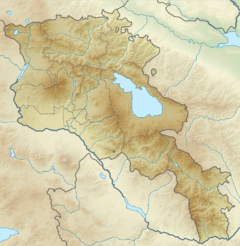astro.wikisort.org - Institution
The Orgov Radio-Optical Telescope, also known as ROT54 or the Herouni Mirror Radio Telescope, is a radio telescope in Orgov, Armenia. It was built between 1975-1985 and was active between 1986-1990 before its use was halted. Subsequently, many attempts have been made to restore and restart the ROT54. It was registered as a historical and culturally significant Armenian monument in 2002 (monument N: 2.114.19.11.). [citation needed]
 | |
| Named after | Paris Herouni, Orgov |
|---|---|
| Location(s) | Orgov, Aragatsotn Province, Armenia |
| Coordinates | 40°21′03″N 44°14′27″E |
| Altitude | 1,711 m (5,614 ft) |
| Built | 1975–1985 |
| First light | 1986 |
| Telescope style | optical telescope radio telescope |
| Diameter | 54 m (177 ft 2 in) |
| Secondary diameter | 5 m (16 ft 5 in) |
 Location of Orgov Radio-Optical Telescope | |
This article is missing information about Use between 1987 to 1990, purpose/use, technical details, additional details on attempts to restore the ROT54, comparison between similar radio-telescope systems. (October 2021) |
Specifications
The telescope is located at the RRI Aragats Scientific Centre in Orgov, Armenia. It is on Mount Aragats,[1] at a height of 1,711 metres (5,614 ft).[2]
The radio telescope has a diameter of 54 m (177 ft). It is hemispherical, and fixed to the ground, with a movable secondary mirror with a diameter of 5 m (16 ft).[1] This provides a useful diameter of 32 m (105 ft). It has a surface accuracy around 70/100 μm, giving an operating wavelength of 30-3mm (10-100 GHz),[3] and was originally designed to observe down to 1 mm (300 GHz).[1]
The optical telescope has a 2.6 m (8.5 ft) mirror, with a 10 m (33 ft) focal length.[1]
History
Development
In 1964, Paris Herouni proposed the concept of the Heruni Radio-Optical Telescope to Sergei Korolev. Korolev approved Heruni's proposal and after various delays, the construction of the telescope would began. The development began in 1975[1] with the active phase of the construction taking place between 1981 and 1985.[citation needed]
Demolitions were set on the slope of Mount Aragats to create the pit for the dish. Afterwards, concrete would be poured into the pit. 3600 shields made of high-strength alloys based on aluminum with additions of copper, magnesium and manganese, in turn attached to iron pipes, were "walled up" in the pit. Of particular technical difficulty was the polishing of the shields (with an average size of one by one meter) that covered the telescope mirror, because the reception of radio waves in the millimeter and sub-millimeter ranges depends on the quality of the surface of the shields. Therefore, each panel of the mirror was hand-molded and precision-finished to within 70 microns.
The telescope went operational on 1986[3] and in same year, Heruni received patent No. 1377941 with the assignment of the invention to the name “Mirror Radio Telescope Heruni”. The remaining infrastructure was completed in 1987.
Operations and observations
The observatory was active between 1987 and 1990.[2] An explosion of the red giant (the twin star of the constellation Gemini) was recorded, numerous articles were published in scientific journals of the USSR and abroad, and reports were made at conferences.[citation needed]
The Telescope was subjected to, but not damaged, by the 1988 Armenian earthquake.[2]
Decommission and restoration attempts
Telescope operations ceased around 1990. In the mid-1990s a plan to restore the telescope to use it for astronomy was proposed.[3] It was subsequently restructured in 1995-2010, with new control computers, new feeds, and observations in collaboration with the Astronomical Society of Russia and the National Technical University of Athens.[2]
Future operation of the telescope, will necessitate further upgrades to the control systems, carrying out comprehensive adjustments, replacing outdated analog sensors with digital ones, and modernizing the data processing systems. According to experts,[who?] these upgrades will cost approximately $25 million.
In 2012, movement of the secondary mirror was rendered impossible due to a defective control arm. The state at the moment cannot allocate the required funds, so the entire research complex is being mothballed. With more than half of the buildings on the territory of GETSAI abandoned, the ROT 54 / 2.6 operations again ceased in 2012.[citation needed]
In 2018/2019, a restoration project was prepared, so that the telescope can be used in the European VLBI Network.[2] The implementation was planned to begin in 2019.[citation needed]
See also
- Arecibo Telescope
- FAST
References
- Herouni, Paris M. (2007). "Measured Parameters of Large Antenna of ROT-54/2.6 Tell about Absence of Big Bang" (PDF). National Academy of Sciences of Armenia Reports. 107: 73.
- Sargsyan, Arevik (4–5 October 2018). "Presentation of ROT-54/2.6" (PDF).
- Martin, J. M.; Rosolen, C. (October 1995). "Perspectives of the ROT 54/32/2.6 in astronomy". Astrophysics. 38 (4): 361–363. Bibcode:1995Ap.....38..361M. doi:10.1007/BF02044713. S2CID 124009116.
На других языках
- [en] Orgov Radio-Optical Telescope
[ru] РОТ-54/2.6 (радиооптический телескоп)
РОТ-54/2.6 или Зеркальный радиотелескоп Геруни — первый в мире радио-оптический телескоп. Создан советским учёным армянского происхождения Парисом Мисаковичем Геруни в 1985 году[2][3][4].Другой контент может иметь иную лицензию. Перед использованием материалов сайта WikiSort.org внимательно изучите правила лицензирования конкретных элементов наполнения сайта.
WikiSort.org - проект по пересортировке и дополнению контента Википедии